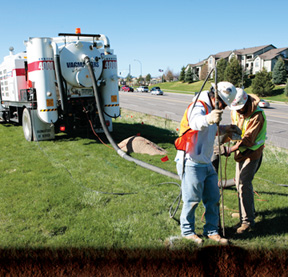Subsurface Utility Engineering (SUE)
SUE is a technology-driven process, not one specific technology. Therefore, SUE is customized to fit individual projects. Simply stated, it identifies the quality of utility information needed to design a project and then gathers and manages the appropriate level of information. SUE combines civil engineering, geophysics and surveying, surface geophysics, vacuum excavation and mapping technologies.
In design, permitting, construction and documentation, SUE can eliminate unnecessary expenses, reduce the safety risks of underground utility jobs and give you a competitive edge in bidding and productivity.

Levels of SUE services
The American Society of Civil Engineers (ASCE) has established guidelines for the information provided in levels of service. Each level builds on information provided in lower levels.
- Quality Level D - Research of existing records and oral recollections.
- Quality Level C - Surveying and plotting visible above-ground utility features, along with experienced professional judgment.
- Quality Level B - Applying surface geophysical methods to determine the existence and approximate horizontal position of subsurface utilities.
- Quality Level A - Precise horizontal and vertical location of utilities obtained by the actual exposure and subsequent measurement of subsurface utilities, usually at a specific point. The most comprehensive level of service, Level A uses information gathered from Hydro/Air Vac excavation and includes a CAD file that depicts location and depth of utilities.
Hydro/Air Vacuum Excavation
The SUE process of researching, locating, hydro/air vacuum excavation and data analysis provides precise information that can be used to create accurate maps of existing underground utilities.
Vacuum excavation uses pressurized water or air to break up the soil, which is then vacuumed out of the hole, up to 8- to 12-inch square and as deep as the utility. Engineers then measure the precise location of the utility lines and create the CAD file report.
Small-hole techniques, where the work is done from above ground through a small opening, minimizes restoration and easily triples productivity compared with conventional open pit repair and backfill methods.
Knowing the exact location of underground utilities eliminates the risk of a backhoe, pick or shovel accidentally striking a fiber optic cable, gas pipeline, electric power line or water main.
Hydro/Air Vacuum Excavation Applications
- Underground utility location verifications
- Natural gas pipeline bell joint leak repair
- Cathodic protection installation
- Gas or water line service terminations or installations
- Potholing of utilities
- Manway and valve box cleaning and maintenance
- Directional boring and vacuum excavation
- Test pits / soil samples
- Underground line exposure
- Sludge removal
- Pipeline tie-ins and maintenance
- Range box / monument placement
- Culvert and drain cleanout

Damage Prevention
Damage prevention can help reduce or eliminate facility damage and third party claims, translating into a higher profit margin on each job. Through A.J. Ventures damage prevention training, your crews will understand how to effectively and efficiently locate utilities prior to construction, including when to call for help. As a result, your organization can expect reductions in litigations, personal injuries and insurance rates; while seeing improved productivity and stakeholder satisfaction. Damage prevention and safety management of the job is our number one priority.
Cost Control
Tight timelines and even tighter budgets force construction managers to explore all aspects of a job in the planning stage, and to do it more precisely than ever. Subsurface utility engineering provides accurate information before the first backhoe moves dirt. A.J. Ventures consultant team can reduce and eliminate costs and delays associated with redesign, relocation of utilities, utility damage and contractor claims on many projects.
- The City of Richmond avoided $731,425 worth of construction-phase utility adjustments by spending $93,553 to dig test holes, resulting in a savings of $637,872, and cut one year off the project timeline.
- The Maryland State Highway Administration (MSHA) spent $56,000 on Subsurface Utility Engineering SUE services for a highway project, eliminating conflicts and ultimately saving $1,340,000.
For Subsurface Utility Engineering inquiries, please contact:
Mark Fanning – Director of Operations
Office: 303-697-4437
Mobile: 303-356-9458
Markajventures@msn.com
Nancy Fanning – Accounts Director
Office: 303-697-4437
Mobile: 720-641-3971
Nancyajventures@outlook.com
